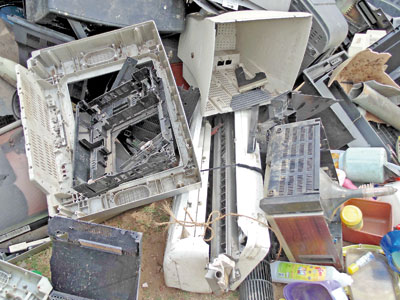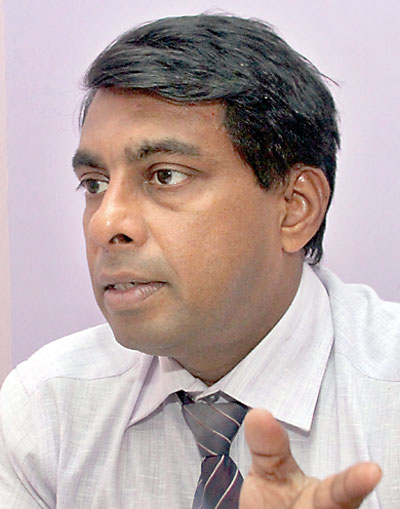News
Experts warn of e-waste being dumped together with garbage
 As the country mourns the dead of Meethotamulla and grapples with what to do regarding this mountain of garbage, a different danger signal lights up bright red.
As the country mourns the dead of Meethotamulla and grapples with what to do regarding this mountain of garbage, a different danger signal lights up bright red.
At the centre of the warning is the children’s toy – the Rubik’s cube with its reds, blues and yellows and the imminent dangers of recycling toxic electronic waste or e-waste.
The Rubik’s cube (a 3-D combination puzzle), one of the world’s best-selling toys, as well as other children’s products are being contaminated as they are being manufactured with recycled plastic containing toxic flame retardant chemicals found in electronic waste, the Sunday Times learns.
This disturbing finding follows a worldwide study by IPEN, a global civil society network; Arnika, an environmental organization based in the Czech Republic and the Centre for Environmental Justice (CEJ) based in Sri Lanka. (See box for study)
It opens up another can of worms which Sri Lanka needs to tackle urgently with regard to the dumping of garbage, many sources were quick to point out.
There is grave danger, warned Dr. Waruna Gunathilake, Acting Head of the Toxicology & National Poisons Information Centre, pointing out that in Sri Lanka there is no ‘sorting’ of garbage and now even toxic e-waste is being dumped along with everything else.

The e-waste range includes almost any household or business item including electrical and electronic equipment containing circuitry or electrical components with either a power or battery supply
There is no active policy on the disposal of e-waste, he lamented, underscoring that people just put everything including e-waste and plastic into rubbish bins in their homes and hand them over to the local authorities across the country, who also just discard them anywhere and everywhere.
Now that there is a suggestion to use Muthurajawela as a dumping area, Dr. Gunathilake said very red were the danger signals of toxic e-waste contaminating not only this area but also leaching into the very groundwater system and slowly poisoning the people.
The e-waste range is huge, the Sunday Times learns and includes almost any household or business item including electrical and electronic equipment containing circuitry or electrical components with either a power or battery supply. They can fall under the ‘large’ or ‘small’ item category and include refrigerators, washing machines and dryers, air-conditioners, vacuum cleaners, coffee machines, irons, toasters, computers, laptops, mobile phones, telephones, fax machines, copiers, printers, televisions, VCR/DVD and CD players, hi-fi sets, radios, fluorescent tubes, sodium lamps and electric and electronic tools such as drills, electric saws, sewing machines, lawn-mowers and toys and leisure, sports and recreational equipment such as electric train sets, coil slot machines and treadmills.
“What we need is a solid garbage collection and disposable policy,” says Dr. Gunathilake, adding that strict should be the measures on how to deal with it.
Garbage should be sorted out as biodegradable; plastic and polythene; and e-waste; and dealt with separately. If we don’t do it now, we will be in serious trouble, he warns.
Referring to the Meethotamulla garbage disaster, the inventor of a tried-and-tested compact biogas plant, Srimal Tissera points out that the need of the hour is to stop the ‘accumulation’ of garbage. Management of solid waste is the answer, starting in our homes. For the people, food waste can be turned into the golden goose or ‘artificial stomach’ not producing eggs but biogas for cooking which is a natural energy as opposed to LP gas which is harmful to the environment and also compost which can be used to grow vegetables and fruits.
The ‘waste’ or ‘throw-aways’ fed to the biogas digester can come in different forms — fruit waste, vegetable waste, market waste, bakery waste, home waste or any organic matter and Mr. Tissera knows what he is talking about, for his compact biogas plants are in use in many homes, factories, companies, hotels, schools and universities.
This self-learned inventor warns against the conventional underground biogas plants as those have not taken Sri Lanka’s climate into account. What he does is after the above-ground construction of the digester, he adds a little cow-dung to it to set off the activation as cow-dung has low-calorie digestive anaerobic bacteria. To turn them into high-calorie digestive bacteria, he puts in a ‘culture’ he has developed using ayurvedic medicine and herbal extracts. Thereafter, the digester can be fed with anything organic including fats and oils, plants and trees cut into small pieces and even paper.
The biogas produced is 35% carbon dioxide and 65% methane, he says, adding that there is also the production of about 2% hydrogen sulfide.
“Once the biodegradable stuff is taken out from the garbage in homes, offices and other workplaces such as factories and fed to biogas plants, what the local authorities would have to collect in their areas would be polythene, plastic and bottles which could then be recycled. The government could, through the state banks, provide loans to people to help set up biogas plants which, in turn, would reduce the huge costs faced by the local authorities in the disposal of garbage,” adds Mr. Tissera.

Dr. Waruna Gunathilake

